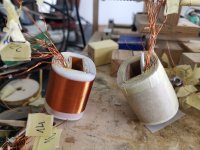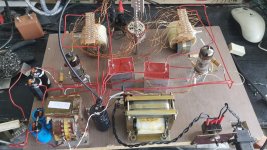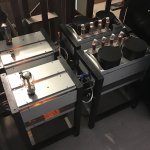This is kinda cheating because I have reworked an old amp, my first amp. But I had to.
In its original form it was too heavy to lift and carry down the stairs to the work shop for any required maintenance. I took the opportuniy to clean up my beginners work and to add DC regulated heat for the two tubes, a 12BH7A and the 45. I know DC heat on an IDHT is excessive but the whole amp is excessive! It was all about Low DCR and I nailed that! It is the most dynamic amp I have and the best I have heard. Everything you can do to assist a 45 I have done here. I am just too dang old to cart this amp with its Hammond Army around anymore and had to give in a four-part home. Anyway, I hope you like it. It is not as radical as it once was but old age will get you if you don't plan.
Woww this is not just excessive is super massive, the amount of iron is mind blowing but you did a great job and good idea to split the amp from the power unit, in this way looks I can say "slimmer", also great work on the cabinets...all the best
Impressive build, I really love the wood work with joints, did you made it by yourself? Also agree with Bas about the transformer cover....all the best
Last edited by a moderator:
My Baby Huey PP EL84
Hi Bas,
again a beauty congrats, I also loved your amp on Ikea cabinet so recently I build one too with bamboo cabinet but not Ikea..
Hi everyone,
Just thought I'd share my first amp project,. . . . . . .

That wooden capacitor clamp is a nice touch.
Thanks kissabout2002! All the best to you too. I also have some bamboo projects coming up. (Also not Ikea) But this time I ordered some aluminium top plates to go with them. Because only the sides are made of real bamboo. The bottom which I use is some fake plastic bamboo...hence the aluminium.Hi Bas,
again a beauty congrats, I also loved your amp on Ikea cabinet so recently I build one too with bamboo cabinet but not Ikea.. still I love it, but finally soon Ikea will open here in Manila I can't wait.....all the best
Absolutely a beauty congrats, I like the toroidal cover, how did you do that? Well I really don't see any flaws on the wood work I wish I could have your skill on the wood work, most of all how it sound? ....all the best and enjoy the music
Thanks kissabout for the compliments ! The toroidal are the "Supreme" versions of Toroidy audio models, I haven't got much merit on their look. I agree that their shining surface does good in constrat with the mat black paint of the aluminium plate. In any case I can only recommend Toroidy, very serious work and good service (I'm not affiliated, simply a happy customer).
About the performance of these transformers : the PS is getting somewhat hot (I have to measure it, about 55° I would think but my laser/contactless thermometer doesn't work well on this surface). The OPT sound better than the previous models I used in my first build, but they were 25W EI from Edcor and those are specified 50W, so very different. The amp still need some burn-in and with everyone at home I can't play music the way I'm used to so the burn-in and sound evaluation needs more time with less people in the way
And I still need some time to finish my Autoranger and sound-card setup to measure my amps, but right now it's the sailing season here so you know what it means about priority changes with time
Last edited:
Woww this is not just excessive is super massive, the amount of iron is mind blowing but you did a great job and good idea to split the amp from the power unit, in this way looks I can say "slimmer", also great work on the cabinets...all the best
You are most kind, thank you.
I hope you find inspiration in these pages for your own amplifier adventures!
I'm still building to practice, but eventually hope to build a no-holds-barred build once I get a better feeling for tubes, topologies, PS concepts, etc.
Note that this was my first build and I went whole hog... then came back ten years later to make it better. Find a guide, a tested schematic at least, and jump in, it’s the way to learn. Lots of us will offer info and advice... here comes some...
Remember parts can be reused so buy good ones, leave some lead length and consider using terminal strips and just building a bunch of “breadboard” amps. Everything must be built and listened to, short of that is all just theory.
Before you go no-holds-barred for your style/type of tube amp, make sure you’ve committed to a set of speakers. It’s always a marriage, amp and speaker. Some marriages are not meant to be!
I love it, can you please explain how you used a couple of power transformer like the VPT12-2080 as OPT? ....all the best
Using a 50Hz mains toroid for an output transformer will never produce the results claimed.
Firstly the primary inductance will not be more than around 25H, because it doesn't need to be for a 50Hz mains trafo. Too large a primary inductance gives a high ampere-turns level which means the core needs to be bigger, this is simply not a design requirement for mains transformers, the manufacturer wouldn't be thinking "Lets use a huge oversize core and lots of primary inductance incase someone wants to use it as a audio transformer". So that never happens and the laws of physics means you won't be able to support the flux density needed to get low end power, additionally the modest primary inductance, whos impedance drops with frequency, will soak up any power at the lower frequencies as well.
Then we get to the issue of interleaving the windings for the best HF coupling, it simply isn't practically possible on a toroidal core to achieve the same level of careful interleaving on an EI core.
So this leads the simple fact: All the best output transformers are not cobbled together cross-wire mains transformers, and they are not toroidal.
So I am going to call you out on "better than any EI transformer", and I am going to cast shade on your performance claims.
Having been working in the audio industry for many decades in tube amp design, there is a reason why people like Brian Sowter and Majestic don't use toroids (two of the best, if not /the best/) transformer winders in the world (the former winding some of Audio Notes finest transformers).
If the those claims were actually substantiated no one would be using custom EI outputs, including me.
Stick it on an audio analyser in my lab, then we'll see, because what you think you have and what you actually have can be very sobering when then audio analyser tells you everything you thought you had never existed.
I'm not saying you can't get some sound out of a mains trafo wired in this way, lots of people have done it to save money and learn at the same time.
But when you claim its better than anything else, I will just tune out.
Note that this was my first build and I went whole hog... then came back ten years later to make it better. Find a guide, a tested schematic at least, and jump in, it’s the way to learn. Lots of us will offer info and advice... here comes some...
Remember parts can be reused so buy good ones, leave some lead length and consider using terminal strips and just building a bunch of “breadboard” amps. Everything must be built and listened to, short of that is all just theory.
Before you go no-holds-barred for your style/type of tube amp, make sure you’ve committed to a set of speakers. It’s always a marriage, amp and speaker. Some marriages are not meant to be!
Good suggestions. I've built 4 or 5 tube power amps and a few line stages. Even a phono stage or two (all based on others' designs for now). But I'm always learning and trying new things. I'm working on refining my breadboard system so I can quickly build up amps to try them out. Thanks for the encouragement and for your interesting approaches to amps!
This is kinda cheating because I have reworked an old amp, my first amp. But I had to.. . . . .
Nice orange glow from the interior ! Can you post any pics of the build? Also very interested in what you did with the power supply . Do you have a schematic you can post?
Thanks
Attachments
"In prototype phase. Autotransformer Volume Control" nice winding there but they look hideously complicated and a nightmare of stray inductances. They remind me of a fader I have in my bits stash that has a pot built on very similar lines, but no core and less IP/OP's.
A.
A.
Using a 50Hz mains toroid for an output transformer will never produce the results claimed.
Firstly the primary inductance will not be more than around 25H, because it doesn't need to be for a 50Hz mains trafo. Too large a primary inductance gives a high ampere-turns level which means the core needs to be bigger, this is simply not a design requirement for mains transformers, the manufacturer wouldn't be thinking "Lets use a huge oversize core and lots of primary inductance incase someone wants to use it as a audio transformer". So that never happens and the laws of physics means you won't be able to support the flux density needed to get low end power, additionally the modest primary inductance, whos impedance drops with frequency, will soak up any power at the lower frequencies as well.
Then we get to the issue of interleaving the windings for the best HF coupling, it simply isn't practically possible on a toroidal core to achieve the same level of careful interleaving on an EI core.
So this leads the simple fact: All the best output transformers are not cobbled together cross-wire mains transformers, and they are not toroidal.
So I am going to call you out on "better than any EI transformer", and I am going to cast shade on your performance claims.
Having been working in the audio industry for many decades in tube amp design, there is a reason why people like Brian Sowter and Majestic don't use toroids (two of the best, if not /the best/) transformer winders in the world (the former winding some of Audio Notes finest transformers).
If the those claims were actually substantiated no one would be using custom EI outputs, including me.
Stick it on an audio analyser in my lab, then we'll see, because what you think you have and what you actually have can be very sobering when then audio analyser tells you everything you thought you had never existed.
I'm not saying you can't get some sound out of a mains trafo wired in this way, lots of people have done it to save money and learn at the same time.
But when you claim its better than anything else, I will just tune out.
I said it was better than any EI coils I have heard... Not you.
Secondly, it's two 50Hz transformers interleaved if you bothered to look and this makes a 460V@25Hz transformer, not a 230V/50Hz transformer (in that mode, the LF response hits core saturation around 15W@30Hz instead of the 112W@30Hz I measure with two interleaved coils...
Perhaps you should try it instead of trashing it without knowing ANYTHING about it's sound.
I suspect it simply doesn't cost enough to sound good in your opinion.
Oh and your estimate of inductance is off... From Triad:
"1. VPT230-110 = 213 to 439H @ 230V, 50Hz (primaries in series). 304H average from 15 samples.
2. VPT230-220 = 192 to 444H @ 230V, 50Hz (primaries in series). 283H average from 15 samples.
3. VPT230-430 = 93 to 214 @ 230V, 50Hz (primaries in series). 128H average from 15 samples."
This means in interleave the inductance is 4 times that.
I'd gladly "stick it on an audio analyzer in your lab" if you were in Toronto. I'd love to see the results and the possibility of you eating crow is satisfying.
And sorry if this reply is a little snarky, but you effectively told me my opinion is wrong. I don't like that kind of nonsense.
I don't claim that these sound better than Sowter or any other EI coils I HAVEN'T heard, but they do sound better than the Hammond coils I've tried in the same circuit (which make less power, too).
If you use low Rp triode connected tubes, and you keep the ratio low (my monoblocs end up being 1k:6R), you will get great results.
Also, I can't seem to find any EI audio transfomers that are 250W, 25Hz-50kHz, with a primary DCR of 12R that handles 1A peaks, and doesn't care if a faulty tube arcs. YMMV.
Last edited:
Toronto based Plitron builds toroidal audio output transformers. They are expensive and not widely used. The performance claims are pretty high.
Testimonials for PLITRON Toroidal Audio Transformers | Plitron Manufacturing
Testimonials for PLITRON Toroidal Audio Transformers | Plitron Manufacturing
Last edited:
They used to be from Amplimo. He now uses another factory I believe. Menno Vanderveen
Last edited:
- Home
- Amplifiers
- Tubes / Valves
- Photo Gallery




